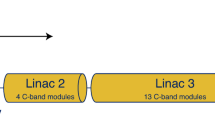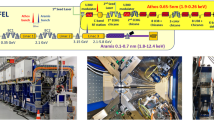Abstract
Regarding the chronologic evolution of accelerator-based light sources, optimization and design issues of cutting-edge-technology insertion devices (i.e., undulators, wigglers, etc.) have been a big competitive concern since the beginning of the twenty-first century. Although these sources are strongly restricted by technological limitations in terms of radiation wavelength, leading X-ray free-electron laser (FEL) facilities are spending considerable efforts to survive in this scientific competition by modifying/updating their insertion devices. In other words, even though they all generate almost identical free-electron laser pulses, advertising a “superconducting undulator based light source” in comparison with a “conventional undulator based light source” may sound more attractive for some scientists. However, in contrast to superconducting undulators, conventional undulators do not require cryogenic cooling systems resulting in a cost-effective operation as a matter of course. Under the circumstances, it is shown that generation of hard X-ray FEL pulses is feasible via unique PPM undulators driven by an electron linear accelerator (linac) within the energy range of 5–10 GeV. The results reveal good consistency with the operating X-ray FEL sources worldwide.









Similar content being viewed by others
References
R. Haensel, Nucl. Instr. Methods Phys. Res. A 303, 405 (1991). https://doi.org/10.1016/0168-9002(91)90278-X
I. Ascone et al., 2004 PETRA III: A Low Emittance Synchrotron Radiation Source Technical Design Report, EDMS ID: D00000000822371, A 1 1
R.E. Gerig et al., Nucl. Instr. Methods Phys. Res. A 649, 1 (2011). https://doi.org/10.1016/j.nima.2010.12.063
T. Shintake and XFEL/Spring-8 Team. In Proceedings of the 29th International Free Electron Laser Conference (FEL07), Novosibirsk, Russia. pp. 216–219
P. Elleaume, J. Chavanne, B. Faatz, Nucl. Instr. Methods Phys. Res. A 455, 503 (2000). https://doi.org/10.1016/S0168-9002(00)00544-1
M. Xie, Design Optimization for an X-Ray Free Electron Laser Driven by SLAC Linac (Calif, Berkeley, 1996).
U. Englisch, B. Ketenoglu, Meas. Sci. Technol. 31, 115902 (2020). https://doi.org/10.1088/1361-6501/ab90bd
T. Tanaka, J. Synchrotron Radiat. 22, 1319 (2015). https://doi.org/10.1107/S1600577515012850
B. Ketenoglu, O. Yavas, Optik-Ijleo 123, 1006 (2012). https://doi.org/10.1016/j.ijleo.2011.07.018
B. Ketenoglu, O. Yavas, Opt. Laser Technol. 44, 1083 (2012). https://doi.org/10.1016/j.optlastec.2011.10.006
B. Ketenoglu, A. Aydin, O. Yavas, Can. J. Phys. 97, 1177 (2019). https://doi.org/10.1139/cjp-2018-0672
M. Altarelli, Nucl. Instr. Methods Phys. Res. B 269, 2845 (2011). https://doi.org/10.1016/j.nimb.2011.04.034
B. Faatz et al., Nucl. Instr. Methods Phys. Res. A 635, S2 (2011). https://doi.org/10.1016/j.nima.2010.10.065
C. Limborg, Nucl. Instr. Methods Phys. Res. A. 507, 378 (2003). https://doi.org/10.1016/S0168-9002(03)00948-3
M. Yabashi, H. Tanaka, T. Ishikawa, J. Synchrotron Radiat. 22, 477 (2015). https://doi.org/10.1107/S1600577515004658
M. Eriksson et al., In Proceedings of the 7th International Particle Accelerator Conference (IPAC16), Busan, Korea. pp. 11–15
L. Liu et al., J. Synchrotron Radiat. 21, 904 (2014). https://doi.org/10.1107/S1600577514011928
L. Liu, R.T. Neuenschwander, A.R.D. Rodrigues, Phil. Trans. R. Soc. A 377, 20180235 (2019). https://doi.org/10.1098/rsta.2018.0235
A. Aydin, B. Ketenoglu, E. Bostanci, Indian J. Pure Appl. Phys. 58, 635 (2020)
D. Ketenoglu, E. Bostanci, A. Aydin, B. Ketenoglu, Turk. J. Phys. 43, 551 (2019). https://doi.org/10.3906/fiz-1909-5
Author information
Authors and Affiliations
Corresponding author
Additional information
Publisher's Note
Springer Nature remains neutral with regard to jurisdictional claims in published maps and institutional affiliations.
Rights and permissions
About this article
Cite this article
Ketenoglu, B. Optimization and Design of Cutting-Edge-Technology Tools for Natural Sciences Research in the Twenty-First Century: X-Ray Free Electron Lasers. Braz J Phys 51, 1007–1016 (2021). https://doi.org/10.1007/s13538-021-00877-9
Received:
Accepted:
Published:
Issue Date:
DOI: https://doi.org/10.1007/s13538-021-00877-9




